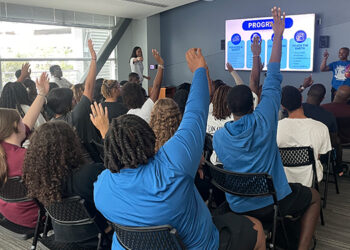Illinois State University Campus Recreation ran a campaign in 2017 to become more sustainable simply because, it was the right thing to do said Dawn Sanner, the executive director of campus recreation at the university.
“Illinois State University includes the promotion of an environmentally sustainable campus as a goal in the university strategic plan,” said Sanner. “The university administration also established a fund to support sustainability projects known as the Student Sustainability Fund. The Student Sustainability committee is responsible for recommending and selecting initiatives for completion. Our participation in these efforts is support by a commitment to help our students reach their goals in this area and others.”
In making an effort to improve the wellness of the campus population, without compromising resources for future generations, the department has instituted numerous sustainable initiatives. Some of these sustainable steps include:
LED Lighting — Campus Recreation replaced lighting throughout the Student Fitness Center to a new sustainable LED option that reduced energy consumption and operating cost by up to 80 percent. The new lighting is fully recyclable and has no mercury or other hazardous material.
Sustainable Picnic Tables — The Office of Sustainability partnered with Campus Recreation to place sustainable picnic tables in front of the Student Fitness Center. Made from recycled materials, these tables are ADA (Americans with Disabilities Act) accessible for all to enjoy.
Water Bottle Stations — The Student Fitness Center was one of the first facilities on campus to install water bottle filling stations. They have a total of nine stations installed throughout the facility. Since their implementation, nearly 4.5 million bottles have been refilled.
Bike Share Program — Campus Recreation purchased new Sun Cruz bikes for the Reggie Ride Program that are more durable to keep up with the high demand of this sustainable travel program. Since implementation of the program in spring 2014, these bikes have been rented nearly 8,000 times, providing a great way to get around campus.
Green Equipment — Campus Recreation invested in sustainable fitness equipment. Currently there are two Woodway Curves in the facility. These treadmills are self-powered, requiring zero electricity. The unique curved design also offers a challenge for the entire body to burn up to 30 percent more calories than any other treadmill.
As Katie Birdsall, the assistant director of facilities explained, there is no one-size fits all approach to being sustainable within your facility. “I think the biggest challenge is knowing that there are multiple facets to sustainability: environmental, economic, cultural and social,” she said. “Though you may be making efforts to be sustainable in one realm, you sometimes lose out in another. For example, we currently use towels and disinfectant spray to clean our equipment as opposed to disposable pre-moistened towel system. With this decision, we are not generating a large amount of waste nor spending money replacing disposable towels on an annual basis. But we do spend money on supplies and use a great deal of water to wash our towels on a daily basis. They key is determining the values that you hold at your institution, and making the best decision based on those values.”
In order to help mitigate some of the challenges, partnerships across campus are essential. According to Sanner, collaboration has been crucial to their success. “Our Office of Energy Management works to help us find the right solutions and document the impacts of initiatives,” explained Sanner. “The Facilities Planning and Facilities Operations department are responsible for designing and implementing our ideas. Our Sustainability office works with the Student Sustainability committee with our Student Government Association to bring the initiatives to campus. Often academic departments can either provide a research opportunity for students or can provide expertise to the project. The ideas come from various areas — the review and implementation is a shared responsibility and a shared commitment.”
Expert Advice
“One piece of advice is to consider university expectations and infrastructure in your decisions,” added Sanner. “We frequently get questions about putting solar panels on the facility or using sustainable equipment to return energy to the grid, but those are not options for us as our mechanical system cannot easily be retrofitted to make this happen. Finally, please remember sustainable programs are not simply defined by a focus on environmental sustainability or a focus on facility. Effective use of all of our resources (including our human and financial resources) should be part of department decisions.”










